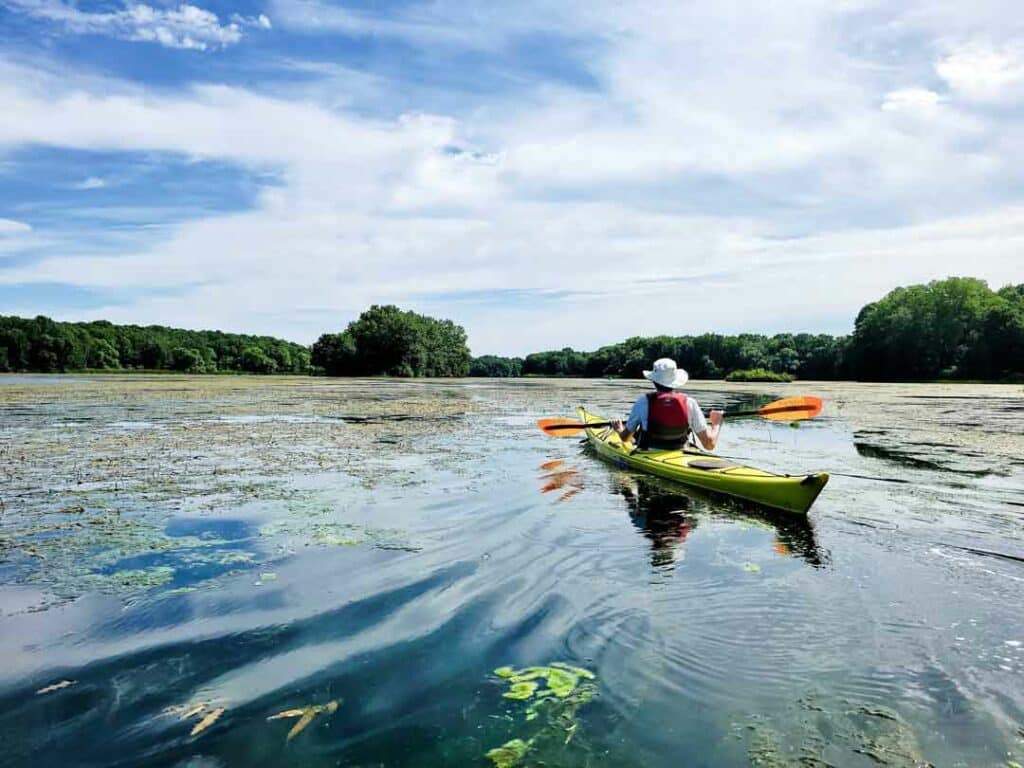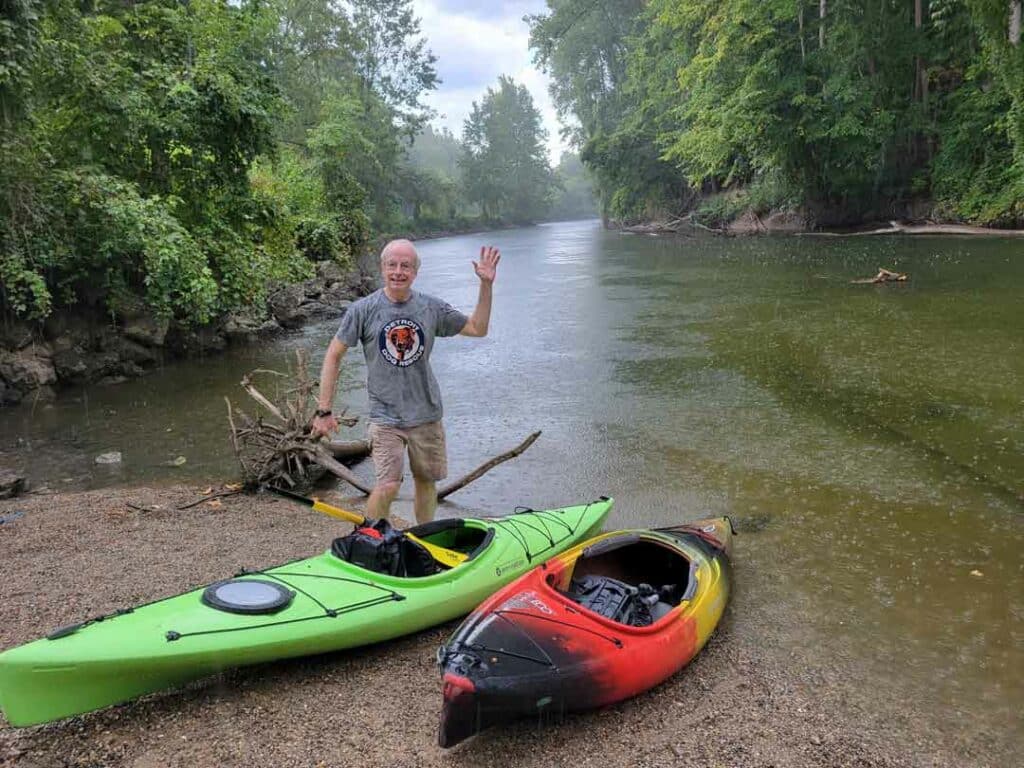Paddle the entire length of the Huron River Water Trail and get recognized for completing the Huron104! We added biking to our paddling adventures for a fun summer of river recreation.

We had just finished bicycling along Washtenaw County’s Border to Border Trail from Dexter Huron to Hudson Mills Metropark to retrieve our car, load up our bikes, and then go back to Dexter Huron for our kayaks. “Let’s do it this year,” my husband Dave said after our first kayak outing of the year. By which he meant, let’s do the Huron104—which entails paddling the entire length of the Huron River Water Trail (HRWT) from Proud Lake State Recreation Area to Lake Erie in one year. For paddlers who have traversed “the 104,” HRWC records their names in the HRWT Register of Finishers.
Paddlers can complete the mission either in sections or continuously, in either direction (I’d love to hear from anyone who has done it upstream!). Those managing a continuous paddle receive special recognition. Dave and I weren’t hardy enough for the continuous trip with overnight camping at the four river-only access campgrounds on the Huron. We decided to break up the water trail into manageable sections of about 10 miles, each taking around 3 hours, with an 8–12-mile bike ride to return to our car or kayak each day. Most of these outings took about 5 hours, counting travel time, loading, paddling and biking. With a bit of planning and copious use of HRWC’s Paddler’s Companion, we (mostly Dave) planned out 15 trips, which we typically completed on a Saturday or Sunday with good weather.
Our Trip
Our first outing was the venerable Hudson Mills to Dexter Huron stretch. Super popular with everyone from diehard paddlers to families with young children, this stretch offers waters clear enough to spot fish, logs full of turtles, and tunnels of trees and wildflowers on both sides of the river. Equally pleasant, the bike back was all on the Border to Border Trail— this nearly completed multi-use pathway traverses Washtenaw County from its Northwest to Southwest border, mostly along the Huron River.
We started our next paddle at the HRWT Trailhead at Proud Lake State Recreation Area and made our way more or less down the river, picking up where we left off the last trip. The river changed character many times.
An “Up North” feeling
Much of the river runs through state recreation areas (Proud Lake and Island Lake) and Huron-Clinton Metropark lands (Kensington, Huron Meadows, Hudson Mills, Dexter-Huron and Delhi), as well as a state-designated Natural Rivers District, which stretches from Kent Lake to Barton Pond, prohibiting any building of homes or other structures within 150 feet of the river. This gives these stretches of the river an “Up North” feel. It was hard to believe we were less than 20 miles from a major city!
Downstream of the Natural Rivers District—outside of the cities of Ann Arbor, Ypsilanti, Flat Rock, Belleville, Rockwood, and South Rockwood—the river runs through four metroparks: Lower Huron, Oakwoods, Willow, and Lake Erie. These parks keep most of their river frontage in floodplain forests, swamps, prairies, and marshes, allowing paddlers to continue their “Up North” experience.
Trail towns
The river cities of Milford, Dexter, Ann Arbor, Ypsilanti, and Flat Rock are all “trail towns,” where paddlers and bikers can venture off the trail to enjoy parks, fishing and paddlesports guides and outfitters, ice cream and coffee shops, campgrounds, hotels, and restaurants.
Lakes and impoundments
Another large proportion of the river runs through flatwater paddling areas, including large lakes created by dams, including Kent Lake, Barton Pond (where Ann Arbor pulls its drinking water supply), Argo Pond, Superior Pond, and Ford and Belleville Lakes. I have to admit, these were not my favorite stretches. These areas were where we encountered the murkiest waters, algae mats, motorboats on the larger lakes, and sometimes winds that made paddling harder. Another chain of lakes (naturally created over the history of the river’s shaping and reshaping its banks, bluffs, and sediment) flows through the river’s stretch in Livingston County. This area was a mix of lakeshore homes, folks fishing from boats and lounging on pontoon boats, and marshy flatwater areas.
The bicycling
We generally organized our ‘paddle-pedals’ by dropping off our kayaks at the launching point, then driving to our planned downstream takeout where we would leave our car, and then bike back up to the kayaks. After our paddle trip, we’d drive back to the launch point to pick up our bikes. Through most of the trip, we were able to stay on dedicated bike pathways to shuttle our kayaks, including pathways through the metroparks and Island Lake State Park, the Milford Trail, the Washtenaw County Border to Border Trail, the Lakelands Pathway, and the Down River Linked Greenways Pathway. For areas lacking bike paths, we planned our biking route along paved roads, avoiding roads with high-volume traffic and narrow shoulders.

Tips for trips
- Plan ahead to Leave No Trace!
- For trips that included one of the river’s impoundments, choose a day without too much wind.
- If you prefer quieter travel, fall is a good time to paddle the larger recreational lakes.
- Portaging the dam that creates the impoundment upstream of Flat Rock requires a call 24 hours in advance during business hours (734-782-4454). To avoid this hassle, make this portage a take-out at the end of the Willow and Oakwoods Metroparks stretch. That way, the next trip downstream you can just put in at Flat Rock!
- HuronRiverWaterTrail.org has a wealth of planning information, including a blog on how to break up the trip for continuous through-paddlers who want to camp. The Paddler’s Companion is also available for purchase on the site.
- You can also find more details on the hike-bike trail routes at Michigan Trails Magazine’s website, MiTrails.org.
—Kris Olsson
This blog post is also published in the Huron River Report, Summer 2023.



